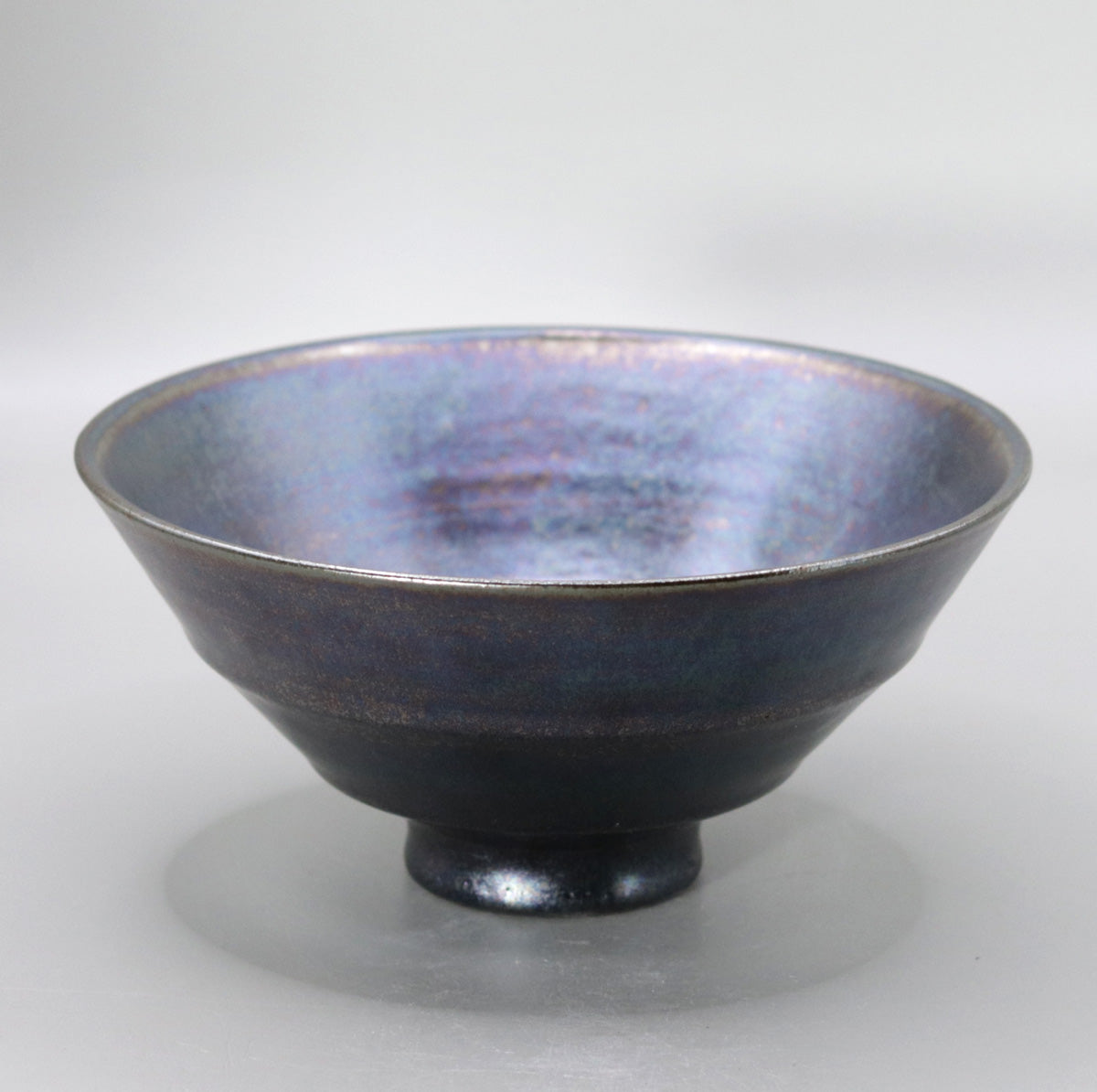Iron glaze kiln-transformed tea bowl (line pattern) by Masaru Okada
Iron glaze kiln-transformed tea bowl (line pattern) by Masaru Okada
Couldn't load pickup availability
Width: 14.8cm Height: 7.0cm
Iron-glazed kiln-transformed tea bowl (Line pattern) by Okada Masaru - "A single line emerges, gliding like a night breeze, with the breath of celadon."
1. The lingering impression of lines swaying in the blue-black air
The greatest highlight of this piece is the horizontal band that appears in the center of the body - a line pattern . The iron glaze shrinks slightly when exposed to the reduction flame, and this thin line appears due to the difference in the thickness of the glaze, and shines quietly like the light of a pale moon stretching through the clouds. The upper part of the body is indigo blue, and the lower part is dark brown, and the gradation that is divided by the line further emphasizes the depth.
2. The Depths of Iron Glaze Kiln Changes - Fluctuations from "Black Porcelain" to "Blue-Black Porcelain"
Tenmoku-type iron glazes turn black when the iron content is 15% or more, but Okada Masaru skillfully fluctuates between oxidation and reduction to create a bluish -black porcelain . By switching the inside of the kiln to a slightly oxidizing state towards the end of the firing process, some of the iron ions are reoxidized, causing hematite crystals to precipitate on the surface. This creates a structural color of blue-purple to green-blue, and under LED light, an aurora-like iridescence appears.
3. The Wonder of Form: The Idea of the "Flat Tea Bowl" in the Lineage of Seto Tenmoku
Mouth design : The slight protrusion without any turning outwards makes it gentle on the mouth.
Body line : The line pattern in the center creates a visual “waist” and gives the entire vessel a sense of firmness.
Base : The cylindrical base is a design similar to the Kikuka Tenmoku and Koryo Tenmoku of Seto kilns, providing both stability and an easy-to-release feel.
This shallow bowl shape, close to that of a flat tea bowl, speeds up the foaming of the matcha while preventing the water temperature from dropping too much, allowing the aroma of the thin tea to rise quickly. In addition, the wide opening does not restrict the movement of the chasen, and creates a visual effect of the bubbles hugging the periphery of the line pattern.
4. Dialogue with history: Linear inscriptions as a bridge from Song ware to Seto
In the Song Dynasty Jian Kiln Kame Tenmoku ware , there are examples where the glaze flow stops and remains in the form of ridges, creating horizontal bands that resemble spatula carvings. On the other hand, in early Seto Tenmoku ware from Japan, the "oniita makeup" that covers the edge of the clay becomes a band, emphasizing the width of the two layers of color. Okada Masaru's line patterns incorporate the elements of both styles and are reconstructed into a modern, minimalist design.
5. Creating a “scenery” in the palm of your hand: Tips for use and storage
In the thin tea tea ceremony , lines overlap on the outside of a doughnut-shaped ring of bubbles, creating a scene reminiscent of the horizon on the surface of a lake.
When serving thick tea , the contrast between the dark brown water surface and the blue-black glaze stands out, adding an extra layer of tranquility.
After use, hand wash with lukewarm water only , wipe off excess water with a soft cloth, and air dry. This will allow the iron glaze to breathe more easily, and dull silver crystals will appear over time.
The expression changes dramatically depending on the light source you choose . Under the warm light of a lantern or candle, the blue-green color sinks deep, while under the white light of an LED it glows mysteriously with a purple tint.
6. Masaru Okada's creative philosophy: The memory of the wind revealed through "lines"
Okada Masaru has condensed the gentleness of the form he cultivated at Kiyomizu Gojozaka and the feeling of the wind caressing the mountainside of Sumiyama in Uji into a single line design. As the artist says, "The wind blows leisurely inside and outside the vessel," the lines are the traces of the wind, and the range of colors in the glaze represents the expression of the changing sky. The ambiguous color of "Ma," which is neither black nor blue, reflects the different atmospheres of the mountains depending on the season and time of day, quietly opening up the five senses of the user.
Conclusion "Line pattern Tenmoku" draws a breeze in the blue-black air. With the historical flow from Song kilns to Seto at his back, Okada Masaru breathes modern life into his work and delivers a landscape hidden in silence to the palm of his hand. Please enjoy the scenery that changes color with time, embracing the "once in a lifetime" spirit of the tea ceremony.
Share








Multi-Column
-
[I will send it to you quickly and carefully]
We carefully package each product in a way that suits it best.
Also, delivery times vary depending on the piece (vessel, etc.).
Items that already come with a box will be shipped within 1-3 days of the order date.
For items that require a box to be made after your order, it will take approximately 30 days for production to be completed and then shipped.
In either case, once we have confirmed your order, we will contact you by email to inform you of the delivery date.
-
[Requests when purchasing pottery]
Even products that look the same may differ slightly in color, shape, size, etc.
The way the glaze is used, the power of the kiln, the firing method, the season, and the humidity also affect the appearance of the pottery.
Please understand the individuality of each piece of pottery and enjoy the unique warmth of handmade.








